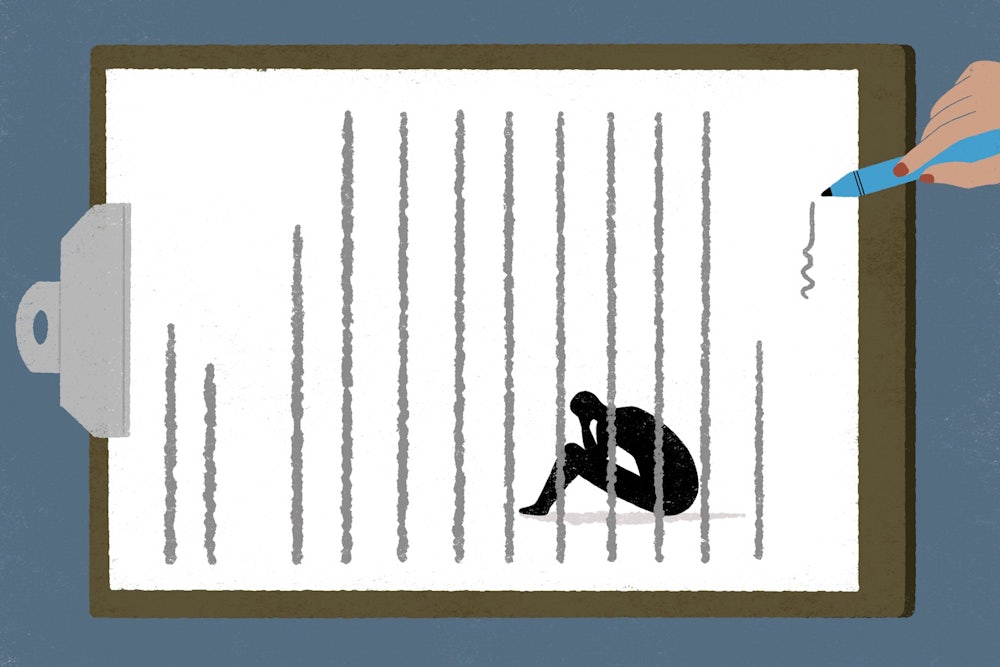Whose conscience is cleaner than that of a social worker? Few jobs demand as much selflessness, or let you be of greater service to those in need; in few jobs will you get paid less while helping people more—the typical measure of occupational rectitude. The social worker cares about people, not status or money. Toiling in the dense bureaucratic thickets of state agencies and adjacent nonprofits, she soothes the angry, comforts the sick, and connects the poor with the resources they lack. (As a rule, we think of social workers as women; upward of 80 percent of them are.) In the moral sweepstakes, her only close competitors are teachers and nurses. Her mere existence stanches the blood pouring from liberals’ hearts.
Since mid-2020, as outrage over police violence reached an apex and calls to defund police departments gained momentum, it has seemed obvious to many on the left that social work is the solution. If nearly a quarter of the people shot by officers are in a mental health crisis, the argument goes, social workers should respond to certain emergencies rather than cops: Fund social services, not police. A 2020 study by Data for Progress found that 68 percent of voters supported the creation of a “new agency of first responders.” In Eugene, Oregon, 17 percent of public-safety calls are currently handled by a three-decades–old program called Crisis Assistance Helping Out on the Streets, frequently cited as an example of how this approach might work. With CAHOOTS, a medic and a crisis worker (who may not be a licensed social worker) respond to calls involving mental health, homelessness, or substance use. Olympia, Washington, launched a similar program in 2019; Denver started a pilot the following year; last year, in Harlem, New York City debuted B-HEARD. The National Association of Social Workers released a brief supporting the creation of such “innovative approaches.” It seems like common sense, the idea that you could reduce violence by diverting money from bloated police departments and sinking it into programs populated by social workers.
Most criticism has, predictably, come from conservatives. “An offender’s mental illness does not mean that a social worker should, or can, respond to his violence,” insisted Charles Fain Lehman of the right-wing Manhattan Institute in a recent letter to The Wall Street Journal. (Nobody, it should be pointed out, is suggesting that “crisis intervention counselors,” as CAHOOTS calls its first responders, should intervene with, say, an active shooter.) But critiques have also come from the left, including from social workers themselves, who suspect that any substitution of their colleagues for police would amount to dressing wolves in sheep’s clothing.
The danger of trading out law enforcement for social workers, or trying to rein in police squads by adding soft-eyed chaperones, isn’t that the unarmed helpers would be ineffective or that crises sometimes require blunt force. The concern is that if you measure in terms of the power to coerce, surveil, and inflict lasting harm, social workers are, thanks to very nature of the job, cops by another name—“key participants,” said Dorothy Roberts, a sociologist and law professor at the University of Pennsylvania, “in a system that is designed to control and punish marginalized communities.”
JMacForFamilies is an organization devoted to fighting the child welfare system—or “family regulation” system, as its critics often call it. Jasmine Wali, the director of advocacy at JMacForFamilies, explained, “Social workers are still going to put people in jail if they’re in crisis,” if that crisis isn’t easy to handle, and they can’t “just talk the person down.” In homeless shelters, staff members trained in social work call the police “on everything,” just as they do in group homes for children in the foster care system “if a child misses curfew, or a child is throwing things or having a tantrum.” Social workers administer urinalyses or other drug tests, which can result in people losing eligibility for social services. In the family court system, so much of what they do “is like parole work,” said another social worker I spoke to. Between 2000 and 2020, among 54 cases of people arrested for self-managing or helping self-manage an abortion, 6 percent were reported to the police by social workers, according to a report by If/When/How.
“Oh, so you want to be put in jail nicely?” said Kamaria Excell, who works with JMacForFamilies. “Cuz that’s all that’s going to happen.… I’m not gonna show up necessarily with a gun.… I’m gonna have my sweater and my notebook,” but “you’re going to jail.” Backed against a wall—or just following the protocols of the agency or nonprofit that employs them—the social worker calls the police.
As a condition of their licensure, social workers must report any suspected abuse or neglect of children to child protective services; if they don’t, they may face legal consequences. (Depending on the state, educators, health care professionals, and some other state employees are also mandated reporters.) To the uninitiated, it seems obvious that social workers should have to do something about problems they observe, that the private sphere should not be allowed to hide its violence without repercussion. Indeed, a foundational premise of mandated reporting is that the intervention of the state will help more than it hurts, said David Shalleck-Klein, a former lawyer at the Bronx Defenders who recently founded the Family Justice Law Center, an organization that seeks to hold government agencies accountable for illegally separating parents and children.
But only a quarter of children end up in foster care because of abuse; the majority are put there because of alleged neglect, the definition of which, Shalleck-Klein said, is “unbelievably subjective”—and often functions as a handy shorthand for poverty. Nationally, the families of more than half of Black children will be investigated by child protective services before those kids turn 18; in much of the country, more than one in 10 Black kids will be removed from their home. In New York City, Black families are six times more likely than white families to be investigated and 11 times more likely to experience a separation. If social workers are by and large earnest, gentle, well-intentioned individuals, they are also unavoidably narcs, bound by laws demanding that they rat on the very communities they’re supposed to help.
In their defense, mandated reporters go through trainings that usually focus on how and when to make a call, not what happens after. Trainings are often “vague,” said Joyce McMillan, the founder of JMacForFamilies, whose children were removed from her home in 1999 for two and a half years. (McMillan founded the group to advocate for families who have similarly suffered.) The curriculum makes social workers “afraid not to report things that they could simply assist a family with.” Instead, they want to “cover their own ass” because it’s “better to be safe than sorry.” Some organizations, recognizing the murkiness, have devised layers of review. Many social workers recognize the “nuance” of situations, suggested one I spoke with—they’re trained, after all, to “live in the gray”—but when I asked her whether social workers shared a common understanding of what constituted a “reasonable” suspicion of abuse or neglect, she laughed.
Typically, an investigation after a report entails a visit to the family’s home. Armed with the threat of removing a child, investigators (many of whom don’t even have previous training in social work) look in cupboards, closets, refrigerators, ask children “to lift up their shirts, pull down their pants,” Shalleck-Klein said.
Perhaps the most damaging actions child protective services can take, short of permanently severing parental rights, are emergency removals, which are incredibly traumatic. “They’re banging on the door,” Shalleck-Klein said, “the police are sometimes involved, there’s screaming, there’s yelling, they’re grabbing a child out of bed, sleeping.” In New York City, as many as a third of these removals are overturned by a judge the very day they’re reviewed; more get reversed in subsequent hearings. The kids remain separated from their parent until a removal is reversed, of course. Child protective services “isn’t trying to harm children,” Shalleck-Klein said. “But they do by discounting the trauma of these removals.”
Instead of mandated reporting, JMacForFamilies proposes “mandated supporting,” an alternative approach that recommends trying to address a problem rather than immediately reporting it to the state. For a child regularly arriving at school without a coat, find him a coat. For a pregnant teenager without medical care, make a doctor’s appointment. “People will literally tell you what they need,” Excell said.
Social work has a powerful “ideological function,” as Dorothy Roberts put it, of persuading people that the child welfare system qualifies for the name, that it is premised on “solving social problems and meeting social needs.” The aura of goodwill and humanity doesn’t just hide harms, it makes them possible to begin with. “The system has benevolent aims,” Shalleck-Klein said: “‘We are here to protect children.’” The rhetoric weaves, he suggested, “a cloak of impunity” around those involved, immunizing them from scrutiny.
But the people most at risk of being entangled have few illusions about what social workers really do. The patina of benevolence has worn off in these communities, if it was ever there to begin with. A 2018 study by the sociologist Kelley Fong explored how poor mothers in Providence, Rhode Island, manage the risk of being reported to CPS. Rather than avoid social services in which they might be surveilled, however, they took care to participate, fearful that any sign of resistance might be turned against them. One mother said it was important to “be careful” when talking about your kids. Study participants avoided discussing housing problems and were loath to enter shelters or involve themselves in home visiting services, where scrutiny might be higher. Service providers “blow things out of proportion all the time,” another mother, Carol, told Fong. They can “just turn on you,” said Gillian.
Leah Plasse, a social worker at a transfer high school in the South Bronx, told me about a conversation she had during an internship at a school, her first as a graduate student in social work at Fordham. (A study relying on 2018 data suggested that in some states, schools generate nearly a third of all reports to CPS.) “What do you do in this school?” a teenage student asked her. “I’m a social work intern,” she told him. “Oh,” he said, comprehending. “You snatch babies.”
Part of the appeal of social work may be born not of our failure to appreciate the reality of what social workers do, Plasse speculated, but rather our intuition that they are in fact a “policing force, just softer.” Social workers promise order that isn’t quite so violent; they uphold the status quo without being ugly about it. “It’s more digestible,” Wali said. Even as social workers offer help or support, they are also a prop, making the public “feel better about these acts of violence by the state.”






